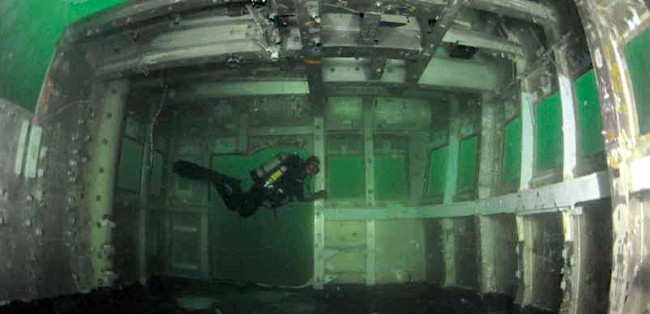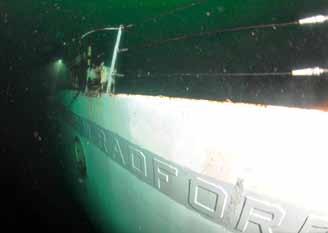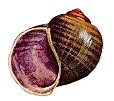USS Arthur W Radford DD-968 (2/2)
Radford Reef
By Hugh M. Carberry
Reef Coordinator
NJF&W Digest, May 2012

Following 16 months of rigorous preparatory work, the 563-foot former U.S. Navy warship Arthur W. Radford was sunk on August 10, 2011 on the Del-Jersey-Land Reef to become one of the largest artificial reefs in the world.
As planned, the vessel sank at a slow, controlled rate and remained oriented in an upright position on the ocean floor. This successful conclusion was a direct result of the collaborative work between reef coordinators from Delaware, New Jersey and Maryland plus the expertise of the Norfolk, Virginia-based American Marine Group (AMG) who prepared the vessel for reefing.
"The reefing team faced many challenges along the way but achieved their goal: to create a safe and extremely clean ship that would provide maximum benefits as an artificial reef for anglers and scuba divers. The Division of Fish and Wildlife expects the Arthur W. Radford reef to evolve into a world-class angling and scuba diving destination."
The vessel's high profile, numerous compartments and tens of thousands of nooks and crannies will provide essential habitat for open and bottom water fish species. It's orientation on the ocean floor, numerous access points throughout - in addition to its colossal size - will offer scuba divers from all skill levels hundreds of areas to explore.
Our reef team for this project consists of the U.S. Navy, the New Jersey, Delaware, Maryland fish and wildlife agencies plus American Marine Group all boasting with pride that the Arthur W. Radford is the cleanest vessel in the world ever reefed. Working with officials from the U.S. Environmental Protection Agency during the cleanup and preparatory phases, miles of coated copper wire and numerous felt gaskets that could potentially contained PCBs were completely removed.
The Arthur W. Radford was a relatively new vessel having been constructed in 1974. Although the likelihood of those contaminants being onboard was extremely remote, the reef team elected to remove these items anyway. In addition, testing was also performed on paint at randomly selected locations throughout the vessel to ensure no PCBs were present. All samples tested came back negative for contaminant. Removal of these potential contaminants and such rigorous paint testing has never before been performed on any warship reefed off the United States. The Arthur W. Radford is a one-of-a-kind clean, green reef.
Measured from the keel to the top of the superstructure, the Radford is 70 feet in height and was sunk at a depth of 130 feet. This means that about half of the water column (from the ocean floor to the surface) contains structure from the Arthur W. Radford. Bottom currents running along the ocean floor will be directed upwards by the ship's hull, carrying nutrient rich water to the surface. These nutrients will create beneficial blooms of plankton creating new feeding areas. Baitfish such as sand lance, round herring, anchovies and butterfish will be found in abundance nearby, feeding on zooplankton.
In addition, for reasons unknown, baitfishes have a tendency to school around high profile structure. Some theorize that these species are either using the high profile structure as a point of reference or find that the structure's shadow conceals them from roving large pelagic fishes. The end result is that large pelagic fishes such as bluefin tuna, cobia and wahoo will discover these schools and utilize the Arthur W. Radford as a prime feeding area.
"Shark anglers will be able to drift across the reef and have the opportunity to catch blue and mako sharks; trolling vessels will have the possibility of catching bluefin tuna and wahoo."
Reef-associated species such as black sea bass, tautog and hake will also be found in great abundance at the Arthur W. Radford site. Once the vessel's tens of thousands of nooks and crannies are fully colonized by hydroids, anemones and blue mussels, which usually takes about two years, this lush growth will attract and provide refuge for shrimp, lobsters and stone crabs, providing an eclectic menu for fish. Early reports from scuba divers who dove the Radford reef between August and October 2011 documented droves of black seabass and even a wahoo. This vessel will last more than 100 years on the ocean floor offering recreational opportunities for generations to come.
Scuba divers from New Jersey who have traveled to Florida to dive the 904-foot aircraft carrier Oriskany or the 522-foot missile range instrumentation ship Vandenberg now have a 563-foot warship in their own backyard. The Del-Jersey-Land Reef is located only 28.5 nautical miles south of Cape May Point. The vessel's high vertical profile makes it the perfect scuba dive for beginner, novice and expert wreck divers.
Beginners can descend to the upper level of the ship (60–65 feet below the surface) and explore the Radford's wheel house and structures that held antisubmarine weapons. Novice divers can swim along the upper deck and peer down into the silos that held tomahawk cruise missiles or penetrate into the chain locker room that held hundreds of shots of chain for the vessel's massive anchors. (Each shot of anchor chain is 15 fathoms, or 90-feet long.) Experienced wreck divers and technical divers can penetrate into the deeper sections of the ship and explore the engine rooms or descend down an elevator shaft to the deepest portions of the ship.
Wreck divers will be pleased to find that the Arthur W. Radford is an extremely "diver friendly" reef. All steel doors and hatches that could potentially close behind scuba divers have been removed, overhanging wires that could ensnare dive gear were taken down and numerous access panels were cut on the sides of the hull for penetrating inside. In addition to the side holes, the upper deck was also cut at strategic locations to increase the ambient light entering the vessel.
The increased visibility within the ships interior resulting from hull and deck modifications along with the cavernous areas inside all provide a target-rich environment for spear gun hunters. In particular, from the helipad deck near the stern to the end of the superstructure near the bow lies a 300-foot alleyway that is wide and high enough to allow three tractor trailers to drive through side-by-side.
"This area will become a spear gun hunters dream for shooting trigger fish, tautog and black sea bass."
The tri-state reef team and American Marine Group did everything possible to make the reef diver-friendly and to sink the Radford upright and intact, but Mother Nature had something else in store. Just 17 days following the ship's deployment, Hurricane Irene made a direct hit over the Del-Jersey-Land Reef. Scuba divers from Ocean City, Maryland who dove shortly thereafter documented that the Radford had broken into three pieces. This news came as a shock to all of the reef partners. Evidently, the energy released from Hurricane Irene was no match for even a former U.S. Navy destroyer. While this unexpected change is unfortunate, ultimately the reef's productivity will increase.

Scuba divers will now have easier and complete access to all compartments and additional ambient light will enter the vessel. Fishing charters and dive boats can dive and fish on each portion separately, eliminating the need to jockey for position while anchoring. The hull breakage also created a measurable increase in the surface area which will increase the reef's fish drawing power. The hull separation will also allow lobsters to enter the interior of the vessel instead of just burrowing beneath the hull at the ocean floor.
The Division of Fish and Wildlife wants to hear about your excursions to the Arthur W. Radford. Contact us at (609) 748-2022 to share your fishing reports and diving observations. We value your feedback, whether complimentary or critical. Your suggestions, comments and observations ultimately make us better reef managers.
The only reports I can find are these videos, from 2011 and 2012.


Questions or Inquiries?
Just want to say Hello? Sign the .